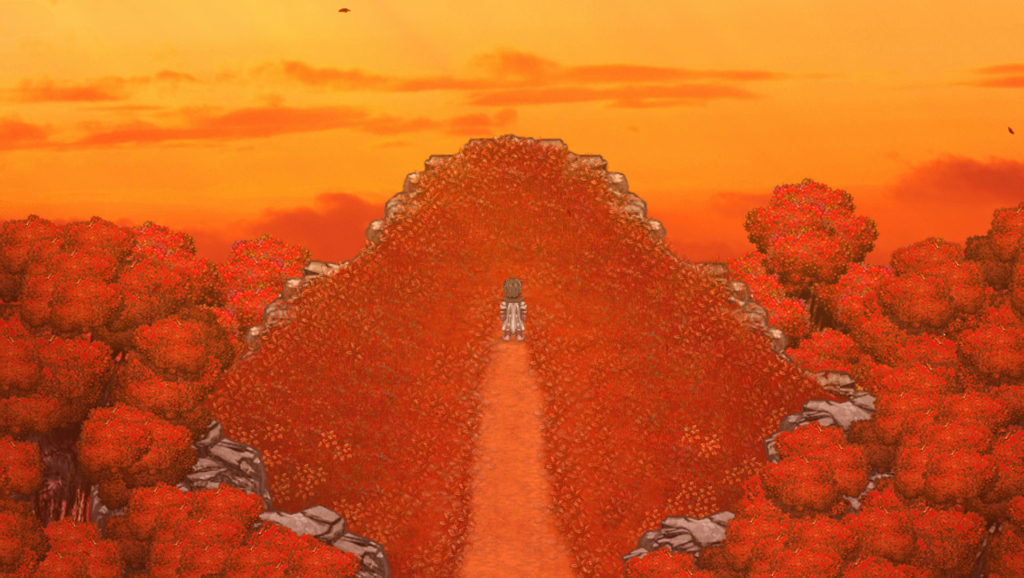Developed by Nomina Games, The Revenant Prince is a story-driven JRPG in the same vein as classics like Chronotrigger and Earthbound. In it, the player assumes control of Troy, a soldier who deserts his platoon in the Lumerian Army after learning that they systematically annihilate the populations of small villages. Guided by an invisible force, and aided by his newfound power to control time, Troy must embark on an epic journey, making the difficult choice of slaying his enemies, or showing them mercy, and dealing with the consequences.

Unlike many classic JRPGs, the story in The Revenant Prince is not set in stone, and is dictated by the player’s actions. These choices are irreversible, and have consequences that bleed into the larger context of the story, even if the results of your actions are not readily apparent. The game meditates heavily on the duality of fate and free will, and incorporates that into the central mechanics. In combat, when you bring an enemy’s hit-points down to zero, they don’t die outright; rather, you’re given the option to execute, or spare your foe. In the larger context of the overworld, sparing an enemy will grant you less XP, however you will still get item drops, and the enemies of the world will get stronger as you level up. You are given the same option during key boss battles, and this changes the story. As far as the growth of enemies is concerned, I did find that they did get slightly stronger, but I never felt incentivised enough to show mercy. So long as you are diligent about upgrading your equipment and empowering Troy, you should be in the clear.
As far as leveling up is concerned, the game does give you room to specialize Troy’s stats to your taste. This is done primarily through the Sphere Grid, where you can invest the points you accumulate through battles and invest them in offensive, defensive, or auxiliary stats. The offensive sphere grid increases general attack power and the efficacy of spells; the defensive sphere grid increases physical defense, magical defense, and Troy’s maximum HP; the auxiliary sphere increases the rate that you dodge attacks, the rate you may take actions during battle, and the chances you can score a critical from an attack. I found myself investing early into defense, but putting more points into attack and luck overall to maximize my damage output.

The combat is relatively fast paced despite that it appears to wear the turn-based wallpaper of the old Final Fantasy games. Instead of waiting for your turn, you may attack so long as you have battle points. Instead of playing with a party of characters that can cover each others weaknesses, you enter combat with three different weapons equipped. There is, however, a cooldown between attacks, and the types of attacks you use dictate how long the cooldown is before your next action.
Quick attacks deal low damage, but have a fast cooldown. Medium attacks deal more damage, but their cooldown is the longest. Special attacks tend to deal the most damage, and also tend to have a special effect added, depending on the weapon you use. Unfortunately, the game doesn’t tell you how to switch weapons, so I will. You can switch between your three weapons using keys A, S, and D. Each weapon also has its own independent cooldown, meaning that you can attack with weapon 1, and then immediately switch to another weapon and attack with that, practically deleting most enemies’ lifebars before they even get to take their turns! My favorite weapon combination was the greatsword, the gun, and the shield. The greatsword dishes out decent damage, and its special attacks damages all of your enemies. While the gun doesn’t put out as much damage, its rapid fire ability can be devastating if even a couple of the rounds manage to crit, making it an excellent tool to finish a foe off. The shield can block most attacks, but the shield bash delays enemies from taking their turns, making it perfect for shutting them down so you can squeeze in a couple extra hits before they can do anything.
This wouldn’t be a JRPG if there wasn’t some sort of limit-breaker, and Troy’s can end most encounters outright. Troy’s limit-breaker builds up energy as he takes damage. When it is full, he can freeze time and you can mash your attack buttons with impunity. If you activate your limit again before it ends, Troy becomes a spectral knight that pummels his opponents with a series of magical explosions. I often find that this attack is often too good to use, and usually save it for a bossfight that I’m struggling with. I had once charged into an optional boss fight when I severely under-leveled. Instead of leaving it alone and coming back after making more progress in the main story, I had instead opted to grind monsters until I leveled up a few times, upgraded my equipment, and challenged the big-bad-wolf only when my limit bar was full. While the boss could still occasionally one-shot me, the fight was over in less than a minute with the use of the limit-break.

The tone of The Revenant Prince is relatively dark. Many of the NPCs ruminate on fate while cracking tongue-in-cheek jokes about how they do the same things over and over again. This being said, the world itself is varied. As you travel between snow-fallen fields, lush forests at different times of day, and the lifeless blights completely devoid of all light and color, you’ll never find yourself stuck in any particular kind of environment for too long. The characters and enemies you encounter fit these settings well, whether they be ferocious white wolves, or the forest-dwelling Bumi tribe (think of the adorable deku sprouts from Legend of Zelda: Windwaker.) I found myself talking to everyone in town, as you may never know who will give you random goodies or might be part of a side quest.
There are problems with the beta build that I played, however. During combat, you are supposed to have additional options to interact with your foes via the M key, such as giving an item to an enemy (if you feed a pastry to a slime, it should be immediately incapacitated.) But the M key simply doesn’t work! The other problem I encountered was that at the end of battle, sometimes the game will fail to load to the correct banner, and it will crash. I found myself saving every 15 minutes because of this glitch, and had lost hours of progress when I wasn’t diligent.
The Revenant Prince is a pretty decent JRPG that attempts to subvert the general expectation that enemies should be destroyed indiscriminately, and practices in giving the player agency in the outcome of both battles and the larger story. The game respects different players’ attitudes towards “the grind” by allowing them to choose how often they would like to encounter monsters in the wild, while offering other kinds of quests that aren’t combat related. There are plenty of well-hidden goodies that will have completionists revisiting various locations while only occasionally beating their heads against their monitors trying to figure what the game wants from them. Despite its glitches and its message lost on my own murderous playstyle, I show The Revenant Prince 7/10.
Check Out The Revenant Prince Trailer:
The Revenant Prince is available for $9.99 for PC via Steam. For more information, please visit: http://therevenantprince.com/
As an Amazon Associate we earn from qualifying purchases.





More Stories
Indika Review for PlayStation 5
Phantasy Star Online 2 New Genesis Collaborates with Atelier Marie and Atelier Ryza
New Trailer for REYNATIS and Square Enix’s Crossover, NEO: The World Ends With You